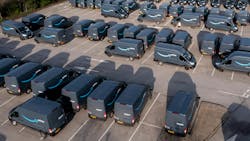Fleet stakeholders and managers are at a critical juncture, having to decide whether to invest in electrification for equipment and vehicles—or not. Those who do risk financial losses and adoption hurdles, but more promising advantages await if they implement assets correctly. Here are a few of the possible pros and cons fleet operators and maintenance experts will likely experience throughout the transition.
Cons of electric equipment
What deterrents are preventing some corporations from making the shift to electric vehicles? Higher initial costs are certainly one of the largest barriers to entry. After all, not only must companies purchase electric vehicles, but also chargers and, in some cases, energy generators to increase their vehicles’ reliability and sustainability.
One study by consulting firm Roland Berger, and commissioned by the Clean Freight Coalition, estimated it would cost th industry nearly $1 trillion to electrify all medium- and heavy-duty trucks, with nearly two-thirds to pay for the charging infrastructure. The heavy-duty BEVs themselves can be three times the cost of diesel trucks.
These initial costs compound, making the return on investment seem far away.
Limited range and charging infrastructure
The world is slowly expanding charging infrastructure for commuters and commercial drivers alike. Mending gaps requires enterprises to install charging stations at their home base to expand charging access, and install others along well-travelled routes to ease range anxiety.
Additionally, battery life for heavy-duty trucks can vary based on various external factors, from temperature to their overall age. This means that workers risk downtime on these business-critical resources if they are not careful about charging schedules. However, this may change as developers, such as those at Delta-Q Technologies and Fullriver Battery, continue to work to make batteries more compact and fast-charging to ease industry pain points.
Specialized training and tools
As well as these problems fleet operators have decades of hands-on experience and know how to repair and maintain diesel-based equipment. But electrification requires workforces to rewrite ingrained habits and upskill through specialized training. Commercial vehicle repair shops and mobile maintenance trucks especially may require new tools or old tools used in new ways, such as:
- High-voltage personal protective equipment (PPE), including arc-rated clothing.
- Battery maintenance tools, like battery diagnostic tools and lifting equipment.
- Electric-specific hand tools, like torque wrenches for electric-specific sockets.
- Tools and skills for repairing charging infrastructure, especially portable models.
Battery degradation and replacement
Another drawback to electrification is battery degradation, which could see vehicles quickly losing range over the years. Costly battery replacements, struggles to find battery recycling outlets, and sourcing replacements could prove time-consuming and labor-intensive for fleets.
This would make monitoring battery health critical for preventing excessive downtime for fleets with electric vehicles. However, the best preventive measure is staying in touch with novel battery research and modeling to discover disruptive designs that could outperform conventional variants, all of which takes fleet operators and managers away from their core duties.
Read more: Analysis: The dark side of electrification
Pros of electric equipment
If these disadvantages exist, then what could convince fleets to make their first electric purchase? One of the most obvious is environmental awareness and compliance, whether set by federal regulation or a fleet’s environmental and sustainability goals.
For example, The Environmental Protection Agency’s third phase of their Greenhouse Gas Emissions Standards for Heavy-Duty Vehicles will require that 25% of new long-haul and 40% of short-haul and medium-duty vehicles be zero-emissions by 2032. And California’s Advanced Clean Truck Rule, although not yet approved by the EPA, is aiming to require manufacturers only sell zero-emissions medium- and heavy-duty vehicles in California by 2036. Even beyond regulations, Daimler Truck North America, International Motors (formerly Navistar), and Volvo Trucks are aiming to become carbon neutral by 2050 and to sell all net-zero-emission vehicles by 2040.
Depending on the progress of these regulations and internal goals, many fleets may need to adhere to similar rules, so transitioning now puts businesses ahead of compliance requirements.
Reduced maintenance requirements
Battery awareness may require effort, but e-equipment and vehicles require less maintenance overall. First, they contain objectively fewer parts to repair than diesel-powered internal combustion engines (ICEs), as electric vehicles only contain about 20 moving parts compared to an ICE’s 2,000.
Because of this component reduction, everything from a forklift to a semitruck could experience less wear and tear and simpler maintenance schedules and repairs. Additionally, diagnosing concerns could be more straightforward with fewer options to choose from when discovering a problem’s source.
Lower operating costs
Despite intimidating upfront investments, electric fleets and equipment can lower operating costs in the long term. The trend will likely remain true, primarily as diesel costs remain volatile. Investing in electric means choosing a cost-stabilized fuel source a company could generate in-house with renewable assets, further reducing utility costs.
Pairing this cost reduction with route refinement and optimized maintenance schedules can also help to offset beginning investments and result in a lower total cost of ownership by the end of the vehicle’s life cycle.
A simulation created by Autofleet’s Fleet Planning Simulator validated this and suggested switching to an electric fleet would lessen expenses more by lowering the number of vehicles needed by 20%.
Quieter operation
Whether in a facility or on a construction site, engines produce copious sound pollution, which can harm drivers over time. Electric options operate with minimal noise interference, improving quality of life on the jobsite and making environments safer for humans and biodiversity.
About the Author
Rose Morrison
Rose Morrison is the managing editor of Renovated. She is a skilled researcher and contributing writer for various industry publications. She specializes in fleet management, related software and sustainability. When not writing, Rose is keenly interested in environmental practices and better building.
